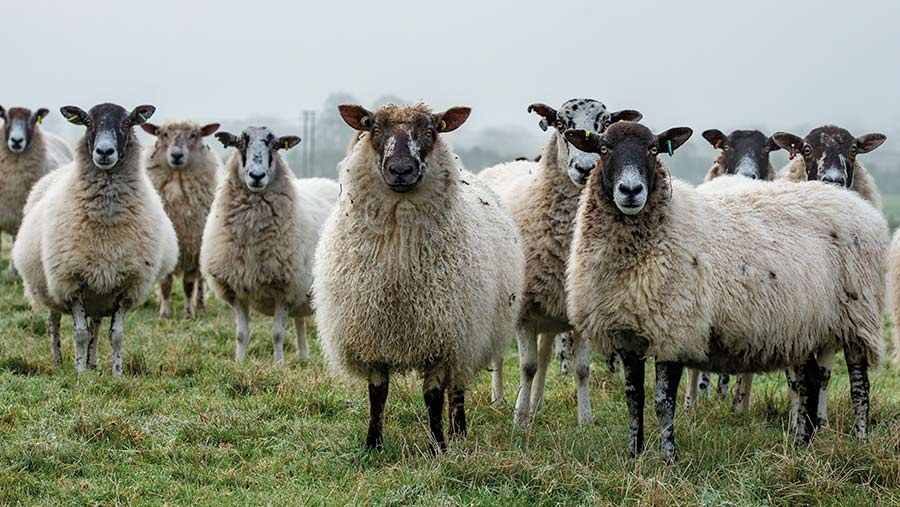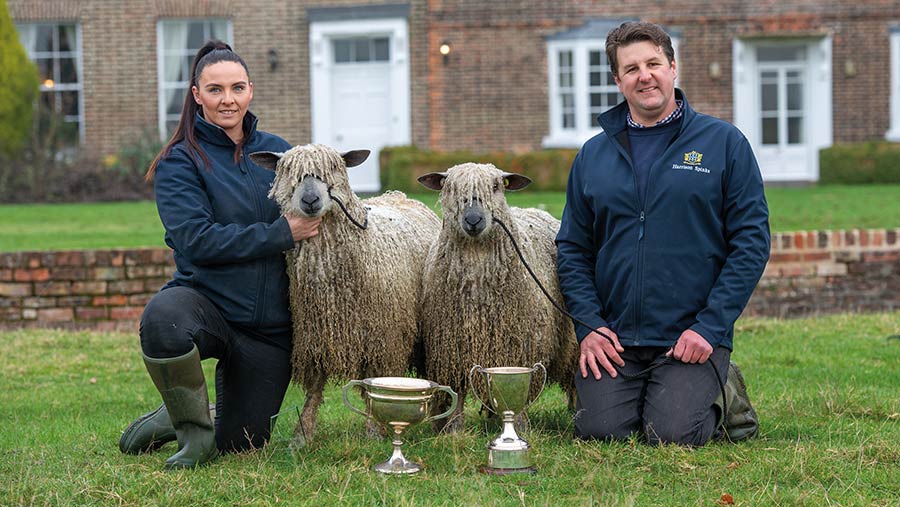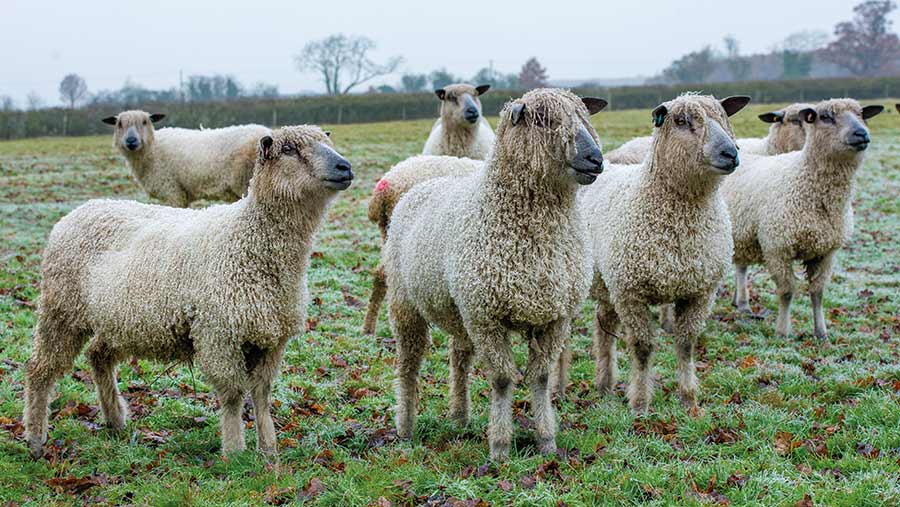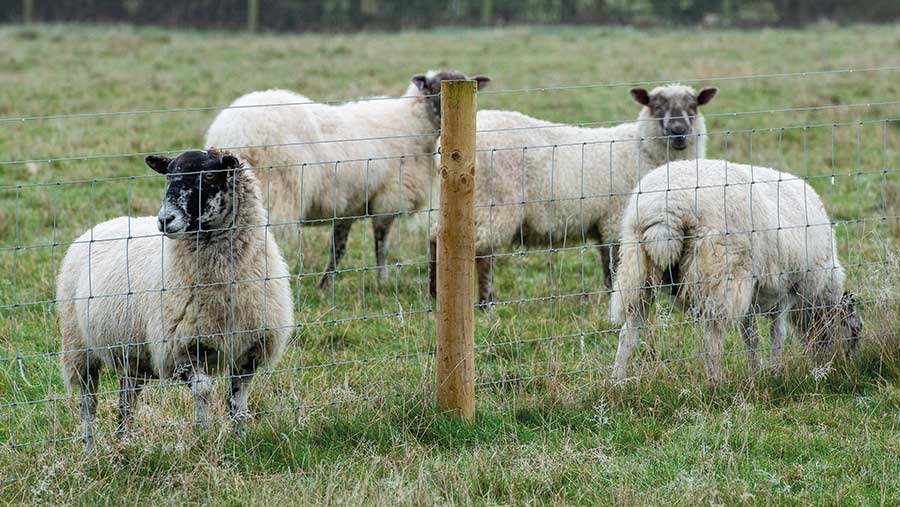How grazing change helped sheep farm cut wormer use
 North of England Mule ewes © John Eveson
North of England Mule ewes © John Eveson Destocking and dividing up fields for rotational grazing have drastically reduced anthelmintic requirements for the two flocks at Hornington Manor Farm, near Tadcaster.
By keeping sheep on clean grazing and taking regular faecal egg counts (FECs), the North Yorkshire farm, which was once seeing anthelmintic resistance issues, is now using wormers sparingly.
The farm, owned by bed-making company Harrison Spinks, has produced materials for mattress manufacturing since 2009.
See also: Why keeping ewes in tip-top condition can help save on wormers
Farm facts – Hornington Manor Farm
- 120ha (300 acres), with 60ha (150 acres) arable and 60ha (150 acres) grassland
- Hemp and flax grown on arable ground with sheep on grassland
- Two flocks run separately – 40-head North Country Mules lambing late March, and 30 pedigree Wensleydales lambing in February
- Sheep rotationally grazed on 2.5-3.5ha (6- to 7.5-acre) paddocks
Liam McPartland has worked at the farm since then and, in 2018, took over from his father as farm manager, working alongside his wife, Becky.
The couple won the inaugural VetPartners sheep sustainability award.
Their first step to changing the sheep system at Hornington was to cut numbers so that stocking density could be reduced and grassland could be rested to relieve worm burden.
Another key change since 2018 has been the establishment of a flock of Wensleydales, a breed that delivers high wool yields.

Becky and Liam McPartland © John Eveson
Sheep management
The McPartlands are running two groups of sheep: 30 pedigree Wensleydale ewes and 40 North Country Mules on the 60ha (148 acres) of permanent pasture, much of which is ridge and furrow.
Wool and grassland management are the main aims of the sheep enterprise. Once flock replacements have been selected, lambs are sold as breeding stock or stores.
“In 2018, we lambed 100 ewes, but the highest number we lambed was 280, which meant there were about 600 animals at grass at once,” explains Mr McPartland.
“It was too much. They were running out of grass, sheep were standing still for too long in 20- to 30-acre fields [8-12ha], and the worm burden was high.”
In their first year, they cut Mule numbers to about 40 and then started building up the Wensleydale flock.
“Wensleydale wool is one of the most expensive types you can buy.
“The flocks are managed completely separately and never the twain shall meet,” he says, describing the Mules as the ideal partnership flock because of their low maintenance requirements.
The Mules are put to commercial, continental tups and lambed in late March.
The Wensleydales lamb indoors in February and most lambs, unless a showing animal, are first clipped in September, when they already have a 10-12.5cm staple of wool.
Within a couple of weeks, their fleece will have regrown enough to give them protection from winter weather elements.
The Wensleydale ewes are clipped in June or July, alongside the Mule ewes.
Wool provenance is very important to the farm’s landlord, with all wool for the mattresses traceable through Harrison Spinks’s partnership with British Wool.

Wensleydale sheep © John Eveson
Rotational grazing and anthelmintics
Fields at the ring-fenced farm have been divided into smaller paddocks to increase rest periods for the grass. Paddocks are fenced with post and rail or stock netting.
“My view is that we are creating permanent rotational grazing paddocks,” says Mr McPartland, who has allocated £4,000-5,000 to infrastructure in the budget each year.
“Every time we fence a paddock, we mole plough a water pipe to a trough.”
Paddocks are now about 2.5-3ha (6-7.5 acres) each and a group of 30 ewes with lambs may spend five to seven days in a paddock when grass is sufficient.
This means lambs can get to seven months before going into a paddock that has already been grazed that season.
Alongside the clean grazing, taking FECs have become a regular part of management. They begin a few weeks after lambing and ensure sheep are free from worms before moving to clean pasture.

Fencing divides rotational grazing paddocks © John Eveson
Last year, all lambs were treated once for coccidiosis, and the Wensleydales were wormed twice, while the Mule flock was only wormed once.
This is quite a reduction from the regular worming in the more heavily stocked system, when resistance to white and clear wormers meant having to use a yellow wormer.
Mr McPartland believes the rotation of sheep is better than any wormer you can buy off the shelf.
A secondary benefit has been increased grass growth, allowing surplus hay and haylage to be produced and sold, securing another income stream for the farm.
When set-stocked, the pasture was producing enough haylage for lambing time – about 40 bales. Now, Mr McPartland is taking about 350 1.2m round bales of hay and haylage from the same acreage.
The sheep are performing well on the system, with the Mules only getting some supplementary hay during and just after lambing.
However, the Wensleydales need feeding year round to maintain condition – about 0.5kg of concentrate an animal a day.
“They’re huge sheep and lovely, but they can get narrow quickly if they’re not consuming enough.”
Sheep health
The farm still has one in-land 16ha (40-acre) field, so that needs to be divided, but the grazing system will stay the same for now, maintaining “near-religious” FEC testing.
Sheep are vaccinated with Heptavac, and last year they were also vaccinated for toxoplasmosis following a scare.
Antibiotics use is also kept to a minimum. The aim is to prevent any problems and identify them quickly, and this is aided by the regular sheep moves, which give a good opportunity to check sheep running past.
The Wensleydales typically receive two zinc sulphate-based foot-baths a year, but aside from that, intervention is rare.
“We are employed to keep these sheep in tip-top condition, so I’d like to think we are quick on any possible issues arising,” says Mr McPartland.
Dedication to worm egg counting, and treating as necessary, has never wavered, according to the farm’s vet, Ashley Marshall, of Westpoint Farm Vets, York.
“They bring samples in without fail and we always have a discussion about our plan – it has always been a collaborative approach,” he says.
“This hard work and perseverance – especially at the beginning, when we had some resistance in the worm populations on the farm – has really paid off and now they have to treat less and less, with the treatment they do have to do being very targeted and always monitored.
“Sheep health is brilliant, and we are protecting the soil, which is in line with the goals of the rest of their business.”
Hemp production for Harrison Spinks
The 120ha (300-acre) farm was bought by bed-making business Harrison Spinks to produce wool, hemp and flax for its manufacturing.
Arable ground will produce hemp for eight out of 10 years, with flax grown inbetween. Natural fibres from the crops are used in making the mattresses.
On top of their own hemp production, grown at Hornington Hall Farm and on a separate block of land, Harrison Spinks runs a co-operative of growers producing a total of 208ha each year.
Co-op members are paid on a tonnage basis for the hemp they deliver to the manufacturer.
The spring-drilled crop has no known pests or diseases and only requires one fertiliser application, usually before emergence or shortly after, to grow to 3-4.25m, ready for cutting at the beginning of August.
A key part of the hemp growing cycle is “retting”, where the crop must be left on the ground for six to eight weeks to kill off natural glues and allow the outer fibres to separate from the woody core.
Harrison Spinks claims the crop improves its sustainability credentials, with every tonne of hemp straw produced absorbing 1.6t of carbon dioxide each year.
